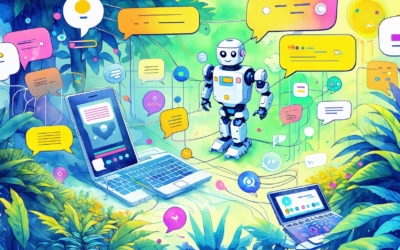Conversational AI, an innovative technology at the forefront of human-computer interaction, is revolutionizing the way businesses engage with customers and users across industries. By leveraging advanced natural language processing (NLP) and machine learning algorithms, conversational AI systems can understand and respond to human language in a natural, contextual manner. This groundbreaking approach to AI-driven communication opens up a world of possibilities for enhancing user experiences, streamlining processes, and delivering personalized, intelligent assistance on demand. From virtual assistants that simplify everyday tasks to chatbots that provide round-the-clock customer support, conversational AI is rapidly transforming how we interact with technology, offering unparalleled convenience and efficiency in an increasingly digital world.
1. What is an example of a conversational AI?
1.1 Defining Conversational AI
Conversational AI, also known as conversational artificial intelligence, refers to advanced technologies that enable natural language interactions between humans and machines. It combines various disciplines, including natural language processing (NLP), machine learning, and contextual understanding, to facilitate seamless and human-like conversations.
At its core, conversational AI aims to mimic human communication patterns, allowing users to interact with digital systems using natural language, whether through text, voice, or a combination of both. This technology is designed to understand the context, intent, and sentiment behind user inputs, enabling it to provide relevant and contextual responses, just as a human would in a conversation.
1.2 Popular Conversational AI Assistants
Some prominent examples of conversational AI include:
- AI Chatbots: These are software programs designed to simulate human-like text conversations, often used for customer service, information gathering, or task completion. Popular examples include ChatGPT, Replika, and IBM Watson Assistant.
- Voice Assistants: AI-powered virtual assistants that can understand and respond to voice commands, such as Apple’s Siri, Amazon’s Alexa, Google Assistant, and Microsoft’s Cortana. They can perform tasks like setting reminders, controlling smart home devices, and answering queries.
- Intelligent Virtual Agents (IVAs): Advanced conversational AI systems that combine natural language processing, machine learning, and other AI technologies to engage in more natural and contextual dialogues. IVAs like Amelia, Moxie, and IPsoft’s Amelia can handle complex queries and tasks across various domains.
- Conversational AI in Messaging Apps: Many popular messaging platforms like WhatsApp, Facebook Messenger, and Slack have integrated conversational AI bots to assist users with various tasks, such as booking appointments, making purchases, or providing information.
- AI-Powered Chatbots in Gaming: Conversational AI is also being used in gaming to create more immersive and interactive experiences, with AI characters capable of engaging in realistic dialogues and adapting to player actions.
These examples demonstrate the growing prevalence of conversational AI across various industries and applications, enabling more natural and efficient human-machine interactions.

What problem does conversational AI solve?
2.1 Streamlining Customer Service
Conversational AI revolutionizes customer service by enabling efficient and personalized interactions through intelligent virtual assistants. These AI-powered chatbots can handle high volumes of customer inquiries, provide instant responses, and resolve common issues without human intervention. By automating routine tasks, conversational AI chatbots streamline customer support operations, reduce response times, and enhance overall customer satisfaction.
Traditional customer service channels often struggle with long wait times and limited availability, leading to frustration and dissatisfaction. Conversational AI addresses this problem by providing 24/7 assistance, ensuring that customers receive prompt and consistent support regardless of the time or volume of inquiries. This scalability and availability contribute to improved customer experiences and loyalty.
Furthermore, conversational AI systems can leverage multilingual capabilities, enabling businesses to offer customer support in various languages, breaking down language barriers and catering to a global customer base. This not only enhances accessibility but also demonstrates a commitment to inclusivity and customer-centricity.
2.2 Enhancing User Engagement
Beyond customer service, conversational AI plays a crucial role in enhancing user engagement across various platforms and industries. By enabling natural language interactions, conversational AI makes it easier for users to navigate complex systems, access information, and complete tasks efficiently.
In e-commerce, conversational AI chatbots can guide users through the shopping journey, provide product recommendations, and assist with purchases, leading to increased conversion rates and customer satisfaction. Similarly, in the healthcare sector, conversational AI can facilitate appointment scheduling, provide medical information, and offer personalized health guidance, improving patient engagement and adherence to treatment plans.
Conversational AI also finds applications in education, where virtual assistants can answer students’ questions, provide personalized learning experiences, and offer tutoring support, enhancing the overall learning experience and engagement.
By understanding user intent and context through natural language processing, conversational AI systems can deliver tailored and relevant information, recommendations, and assistance, fostering meaningful interactions and fostering stronger user engagement across various industries and applications.
3. Is ChatGPT a conversational AI?
3.1 Exploring ChatGPT’s Capabilities
Yes, ChatGPT is a conversational AI developed by Anthropic that leverages advanced language models and natural language processing to engage in human-like dialogue. Its capabilities extend beyond answering queries; it can generate coherent, contextually relevant responses and even create original content like articles, code, and creative writing.
ChatGPT employs a transformer-based neural network trained on vast datasets, enabling it to understand and communicate in natural language with remarkable fluency. However, it is not a sentient being but an advanced language model designed to provide informative and engaging responses based on its training data.
While highly capable, ChatGPT has limitations and biases inherent to its training process. It cannot learn or update its knowledge autonomously, and its outputs may contain inaccuracies or reflect societal biases present in the data it was trained on. Anthropic and other AI researchers continue to explore ways to mitigate these issues and enhance the safety and reliability of large language models like ChatGPT.
3.2 Conversational AI vs. Generative AI
While ChatGPT is often referred to as a conversational AI, it’s essential to distinguish it from traditional chatbots or virtual assistants. Conversational AI focuses on understanding and responding to user inputs in a natural, human-like manner. In contrast, ChatGPT is a generative AI model that can produce original content beyond just conversing.
Generative AI models like ChatGPT are trained on massive datasets to identify patterns and generate new, coherent outputs based on the input provided. This capability allows ChatGPT to engage in open-ended conversations, answer follow-up questions, and even create long-form content like essays, stories, or code.
While conversational AI and generative AI overlap in their ability to understand and generate natural language, generative models like ChatGPT have a broader scope and can be applied to various tasks beyond just conversational interactions. As the technology continues to evolve, we can expect to see more advanced applications of generative AI across industries, from creative writing and content generation to code development and data analysis.
4. Which of the following is a use for conversational AI?
4.1 Conversational AI in Healthcare
Conversational AI has become an invaluable asset in the healthcare industry, revolutionizing patient care and streamlining operations. One of the primary applications of conversational AI in this field is through AI-powered virtual assistants and chatbots. These intelligent systems can interact with patients, gather information about their symptoms, medical history, and provide personalized health advice and recommendations.
Conversational AI assistants can also assist patients in scheduling appointments, refilling prescriptions, and accessing medical records, reducing administrative burdens on healthcare staff. Additionally, they can serve as virtual triage systems, helping to prioritize patients based on the severity of their conditions, ensuring that critical cases receive prompt attention.
Moreover, multilingual conversational AI solutions are breaking down language barriers, enabling healthcare providers to communicate effectively with patients from diverse linguistic backgrounds. This not only enhances patient experience but also ensures accurate information exchange, which is crucial in the medical field.
Another promising application of conversational AI in healthcare is its integration with wearable devices and remote monitoring systems. By analyzing data from these sources, AI-powered conversational agents can provide personalized health coaching, medication reminders, and real-time feedback, empowering patients to take an active role in managing their health.
4.2 Conversational AI in E-commerce
The e-commerce industry has embraced conversational AI as a powerful tool to enhance customer experiences and drive sales. Messenger Bot, a leading conversational AI platform, enables businesses to create intelligent chatbots and virtual assistants that can engage with customers in natural, human-like conversations.
These AI-powered conversational agents can assist customers throughout the entire shopping journey, from product discovery and recommendations to order placement and post-purchase support. By leveraging natural language processing (NLP) and machine learning, they can understand customer queries, provide personalized product suggestions, and offer real-time assistance, reducing friction and increasing customer satisfaction.
Additionally, conversational AI in e-commerce can be integrated with social media platforms and messaging apps, allowing businesses to engage with customers on their preferred channels. This omnichannel approach not only enhances convenience but also enables businesses to gather valuable customer data, which can be used to further refine and personalize the shopping experience.
Furthermore, conversational AI can streamline the checkout process by enabling voice-based or chat-based purchases, reducing abandonment rates and improving conversion rates. Post-purchase, AI-powered virtual assistants can handle order tracking, returns, and customer support inquiries, providing seamless and efficient service.

5. Where can conversational AI be used?
Conversational AI has applications across a wide range of industries and domains. Its ability to facilitate natural language interactions makes it a valuable tool for enhancing customer experiences, streamlining operations, and improving efficiency. Here are some key areas where conversational AI can be leveraged:
5.1 Conversational AI in Finance
The finance industry has embraced conversational AI to provide personalized banking experiences and improve customer service. Brain Pod AI, a leading provider of generative AI solutions, offers advanced multilingual AI chat assistants that can handle financial inquiries, facilitate transactions, and provide tailored financial advice. These virtual assistants are available 24/7, ensuring customers receive prompt and efficient support.
Furthermore, Messenger Bot offers robust chatbot features that can streamline banking operations, enhance security through voice biometrics and fraud detection, and provide personalized financial recommendations. By leveraging AI-driven customer interaction strategies, financial institutions can foster deeper connections with their clients and deliver exceptional service experiences.
5.2 Conversational AI in Education
The education sector has witnessed a transformative impact from conversational AI. AI-powered virtual tutors and assistants can provide personalized learning experiences, answer students’ questions, and assist with assignments. These AI-driven chatbot solutions can adapt to individual learning styles, offer tailored feedback, and enhance educational outcomes.
Brain Pod AI offers cutting-edge multilingual AI chat assistants that can support students in multiple languages, breaking down language barriers and fostering inclusive learning environments. Additionally, Messenger Bot provides affordable pricing plans for educational institutions, enabling them to leverage chatbots for enhanced student engagement and improved educational outcomes.
6. What are conversational AI applications?
6.1 Conversational AI Chatbots
One of the most prominent applications of conversational AI technology is chatbots. Chatbots are software programs designed to simulate human-like conversations through text or voice interfaces. They leverage natural language processing (NLP) and machine learning algorithms to understand user inputs, interpret context, and formulate relevant responses.
Conversational AI chatbots have become increasingly popular in various industries, particularly for customer service and support. Companies like Apple, Amazon, and Google have integrated chatbots into their platforms to provide instant assistance, answer frequently asked questions, and guide users through processes. These chatbots can handle high volumes of inquiries simultaneously, reducing wait times and enhancing the overall customer experience.
Beyond customer service, chatbots are also leveraged for sales and marketing purposes, helping businesses generate leads, provide product recommendations, and facilitate transactions. For instance, e-commerce platforms like eBay and Shopify integrate chatbots to assist customers throughout the shopping journey, from product discovery to checkout.
As conversational AI chatbots continue to evolve, they are becoming more sophisticated, offering personalized experiences, multi-language support, and seamless integration across various messaging platforms and social media channels.
6.2 Conversational AI Virtual Assistants
Virtual assistants, such as Siri, Alexa, and Google Assistant, are among the most well-known examples of conversational AI applications. These intelligent assistants leverage voice recognition and natural language processing to understand and respond to user commands and queries.
Virtual assistants can perform a wide range of tasks, including setting reminders, controlling smart home devices, providing weather updates, playing music, and even engaging in casual conversation. They are designed to adapt to the user’s preferences, learning their habits and tailoring their responses accordingly.
Beyond consumer applications, conversational AI virtual assistants are also being adopted in enterprise settings. For example, Brain Pod AI’s multilingual chat assistant can be integrated into business workflows, assisting employees with tasks such as scheduling meetings, managing calendars, and retrieving information from various data sources.
As conversational AI technology continues to advance, virtual assistants are becoming more sophisticated, offering improved natural language understanding, contextual awareness, and the ability to handle complex queries and tasks seamlessly.
7. Building Conversational AI Applications
7.1 Conversational AI Technologies
To build conversational AI applications, developers leverage a range of technologies and techniques. The core components include natural language processing (NLP) for understanding and generating human-like language, machine learning for training the AI models, and dialog management systems for orchestrating the flow of conversations.
Some key technologies used in conversational AI development include:
- Intent Recognition: Identifies the user’s intent or goal behind their utterance.
- Entity Extraction: Extracts relevant entities (names, dates, locations, etc.) from the user’s input.
- Context Handling: Maintains context across multiple turns in a conversation.
- Language Generation: Generates natural, coherent responses based on the user’s input and conversational context.
- Dialog Management: Controls the flow of the conversation and determines the appropriate response or action.
Leading conversational AI platforms like Brain Pod AI’s Multilingual AI Chat Assistant and Google’s Dialogflow provide developers with tools and APIs to build and deploy conversational AI applications efficiently.
7.2 Conversational AI Use Cases Examples
Conversational AI has a wide range of applications across various industries. Here are some notable examples of conversational AI use cases:
Customer Service
Conversational AI chatbots and virtual assistants can handle customer inquiries, provide product information, and resolve issues 24/7, improving customer satisfaction and reducing operational costs. Companies like Apple and Amazon have implemented conversational AI for customer support.
E-commerce
Online retailers can use conversational AI to provide personalized shopping experiences, product recommendations, and assist with order placement and tracking. eBay and Amazon have integrated conversational AI into their platforms.
Healthcare
Conversational AI can assist with appointment scheduling, symptom triaging, medication adherence, and providing health information. Adama Health and Your Doctor Bot are examples of conversational AI healthcare assistants.
Finance
Financial institutions can use conversational AI for tasks like account inquiries, transaction assistance, and financial advice. Bank of America and Capital One have implemented conversational AI solutions.
Education
Conversational AI tutors and assistants can provide personalized learning experiences, answer questions, and offer academic support. Anthropic’s Claude and Brainly are examples of conversational AI in education.
These are just a few examples of how conversational AI is being applied across various domains. As the technology continues to advance, we can expect to see even more innovative use cases emerge, transforming the way we interact with digital systems and services.





